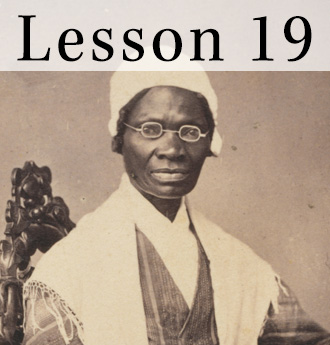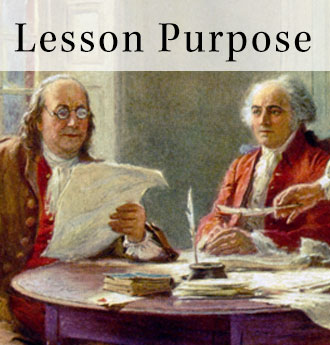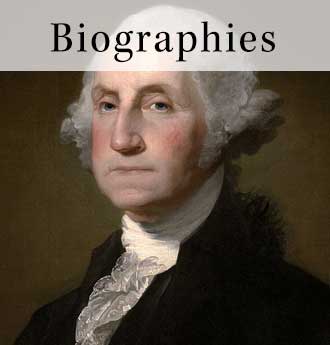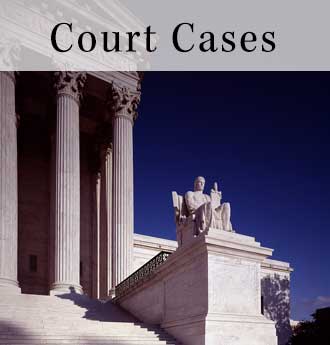Lesson 19: How Has the Equal Protection Clause of the Fourteenth Amendment Changed the Constitution?
The case summaries below were provided by Oyez and licensed under the Creative Commons Attribution-NonCommercial 4.0 International License. Please visit Oyez.org for more case summaries.
Minor v. Happersett (1874)
Facts of the case:
On October 15, 1872, Virginia Minor applied to register to vote in Missouri. The registrar, Reese Happersett, turned down the application, because the Missouri state constitution read: "Every male citizen of the United States shall be entitled to vote." Mrs. Minor sued in Missouri state court, claiming her rights were violated on the basis of the Fourteenth Amendment.
Case Question:
Does the Fourteenth Amendment protect the voting rights of women?
Case Conclusion:
No. In a unanimous opinion the court held that while women were citizens of the United States, and were, even prior to the passage of the Fourteenth Amendment, voting rights were not a "necessary privilege and immunity" to which all citizens are entitled.
Citation:
88 U.S. 162 (Wall.)
Link to case: http://caselaw.findlaw.com/us-supreme-court/88/162.html
Guinn v. United States (1915)
Facts of the case:
The Oklahoma Constitution, while appearing to treat all voters equally, allowed an exemption to the literacy requirement for those voters whose grandfathers had either been eligible to vote prior to January 1, 1866 or were then a resident of "some foreign nation," or were soldiers. It was an exemption that favored white voters while it disfranchised black voters, most of whose grandfathers had been slaves and therefore unable to vote before 1866.
Case Question:
Are these kinds of exemptions to the literacy requirements a violation of the Fifteenth Amendment?
Case Conclusion:
Yes. Justice Edward White went on to strike down the grandfather clause. He saw the Oklahoma law for what it was--a bald-faced attempt to disenfranchise blacks. Justice White wrote that the act "inherently brings" discrimination based on race "into existence since it is based purely on a period of time before the enactment of the Fifteenth Amendment and makes that period the controlling and dominant test of the right of suffrage.
Citation:
238 U.S. 347 (1915)
Link to case: http://caselaw.findlaw.com/us-supreme-court/238/347.html
Buck v. Bell (1927)
Facts of the case:
Carrie Buck was a feeble minded woman who was committed to a state mental institution. Her condition had been present in her family for the last three generations. A Virginia law allowed for the sexual sterilization of inmates of institutions to promote the "health of the patient and the welfare of society." Before the procedure could be performed, however, a hearing was required to determine whether or not the operation was a wise thing to do.
Case Question:
Did the Virginia statute which authorized sterilization deny Buck the right to due process of the law and the equal protection of the laws as protected by the Fourteenth Amendment?
Case Conclusion:
No. The Court found that the statute did not violate the Constitution. Justice Holmes made clear that Buck's challenge was not upon the medical procedure involved but on the process of the substantive law. Since sterilization could not occur until a proper hearing had occurred (at which the patient and a guardian could be present) and after the Circuit Court of the County and the Supreme Court of Appeals had reviewed the case, if so requested by the patient. Only after "months of observation" could the operation take place. That was enough to satisfy the Court that there was no Constitutional violation. Citing the best interests of the state, Justice Holmes affirmed the value of a law like Virginia's in order to prevent the nation from "being swamped with incompetence...Three generations of imbeciles are enough."
Citation:
The Oyez Project, Buck v. Bell, 274 U.S. 200 (1927)
Link to case: https://www.oyez.org/cases/1900-1940/274us200
Skinner v. Oklahoma ex rel. Williamson (1942)
Facts of the case:
Oklahoma's Criminal Sterilization Act allowed the state to sterilize a person who had been convicted three or more times of crimes "amounting to felonies involving moral turpitude."
Case Question:
Did the act violate the due process and equal protection clauses of the Fourteenth Amendment?
Case Conclusion:
Yes. A unanimous Court held that the Act violated the equal protection clause of the Fourteenth Amendment. Since some crimes such as embezzlement, punishable as felonies in Oklahoma, were excluded from the act's jurisdiction, Justice Douglas reasoned that the law had laid "an unequal hand on those who have committed intrinsically the same quality of offense." Moreover, Douglas viewed procreation as one of the fundamental rights requiring the judiciary's strict scrutiny.
Citation:
The Oyez Project, Skinner v. Oklahoma ex rel. Williamson, 316 U.S. 535 (1942)
Link to case: https://www.oyez.org/cases/1940-1955/316us535
Smith v. Allwright (1944)
Facts of the case:
A resolution of the Democratic Party of Texas, a group that the Texas Supreme Court had deemed a "voluntary association," allowed only whites to participate in Democratic primary elections. S.S. Allwright was a county election official; he denied Lonnie E. Smith, a black man, the right to vote in the 1940 Texas Democratic primary.
Case Question:
Did denying blacks the right to vote in primary elections violate the Fifteenth Amendment?
Case Conclusion:
Yes. The Court overruled its decision in Grovey v. Townsend (1935) and found the restrictions against black people unconstitutional. Even though the Democratic Party was a voluntary organization, the fact that Texas statutes governed the selection of county-level party leaders, the party conducted primary elections under state statutory authority, and state courts were given exclusive original jurisdiction over contested elections, guaranteed for black people the right to vote in primaries. Allwright engaged in state action abridging Smith's right to vote because of his race. A state cannot "permit a private organization to practice racial discrimination" in elections, argued Justice Reed. (The Court's decision in this matter was amended on June 12, 1944.)
Citation:
The Oyez Project, Smith v. Allwright, 321 U.S. 649 (1944)
Link to case: https://www.oyez.org/cases/1940-1955/321us649
Griswold v. Connecticut (1965)
Facts of the case:
Griswold was the executive director of the Planned Parenthood League of Connecticut. Both she and the medical director for the League gave information, instruction, and other medical advice to married couples concerning birth control. Griswold and her colleague were convicted under a Connecticut law which criminalized the provision of counseling, and other medical treatment, to married persons for purposes of preventing conception.
Case Question:
Does the Constitution protect the right of marital privacy against state restrictions on a couple's ability to be counseled in the use of contraceptives?
Case Conclusion:
Yes. Though the Constitution does not explicitly protect a general right to privacy, the various guarantees within the Bill of Rights create penumbras, or zones, that establish a right to privacy. Together, the First, Third, Fourth, and Ninth Amendments, create a new constitutional right, the right to privacy in marital relations. The Connecticut statute conflicts with the exercise of this right and is therefore null and void.
Citation:
The Oyez Project, Griswold v. Connecticut, 381 U.S. 479 (1965)
Link to case: http://oyez.org/cases/1960-1969/1964/1964_496
Santa Clara Pueblo v. Martinez (1978)
Facts of the case:
Martinez was a membership case, filed under the Indian Civil Rights Act on a gender discrimination charge. The case claimed that a tribal rule allowing tribal membership to children of male members who married outside the tribe but not to women who did the same violated the equal protection clause of the act.
Case Question:
Does the tribal law violate the equal protection clause?
Case Conclusion:
No. Justice Thurgood Marshall, writing for the Court, denied the claim and eviscerated the law. Contending that a federal cause of action was not required to extend constitutional norms to tribal governments, he urged that grieving Indians sue in their tribal courts so as to preserve tribal self‐determination. Justice Byron White, in his dissent, wrote, "I cannot believe that Congress desired the enforcement of these acts to be left up to the very tribal authorities alleged to have violated them. Extension of constitutional rights to individual citizens is intended to intrude upon the authority of government." The outcome was that the decision strengthened tribal self‐determination, but an Indian with a complaint against a tribal government had little opportunity for relief. Few tribal court decisions were subsequently appealed.
Citation:
Santa Clara Pueblo v. Martinez, 436 U.S. 49 (1978)
Link to case: http://www.oyez.org/cases/1970-1979/1977/1977_76_682
Shaw v. Reno (1993)
Facts of the case:
The U.S. Attorney General rejected a North Carolina congressional reapportionment plan because the plan created only one black-majority district. North Carolina submitted a second plan creating two black-majority districts. One of these districts was, in parts, no wider than the interstate road along which it stretched. Five North Carolina residents challenged the constitutionality of this unusually shaped district, alleging that its only purpose was to secure the election of additional black representatives. After a three-judge district court panel ruled that they failed to state a constitutional claim, the residents appealed and the Supreme Court heard the case.
Case Question:
Did the North Carolina residents' claim, that the state created a racially gerrymandered district, raise a valid constitutional issue under the Fourteenth Amendment's equal protection clause?
Case Conclusion:
Yes. The Court held that although North Carolina's reapportionment plan was racially neutral on its face, the resulting district shape was bizarre enough to suggest that it constituted an effort to separate voters into different districts based on race. The unusual district, while perhaps created by noble intentions, seemed to exceed what was reasonably necessary to avoid racial imbalances. After concluding that the residents' claim did give rise to an equal protection challenge, the Court sent the case back to a lower court, adding that in the absence of contradictory evidence, the District Court would have to decide whether or not some compelling governmental interest justified North Carolina's plan.
Citation:
The Oyez Project, Shaw v. Reno, 509 U.S. 630 (1993)
Link to case: http://oyez.org/cases/1990-1999/1992/1992_92_357
Miller v. Johnson (1995)
Facts of the case:
Between 1980 and 1990, only one of Georgia's ten congressional districts was majority-black. According to the 1990 decennial census, 25 percent of Georgia's population was black, which entitled blacks to an additional eleventh congressional seat, prompting Georgia's general assembly to re-draw the state's congressional districts. After the Justice Department refused pre-clearance of several of the assembly's proposed new districts, the assembly was finally successful in creating an additional majority-black district through the forming of an eleventh district. This district, however, was called a "geographic monstrosity" because it extended 6,784.2 square miles from Atlanta to the Atlantic Ocean. In short, "the social, political, and economic makeup of the Eleventh District tells a tale of disparity, not community."
Case Question:
Is racial gerrymandering of the congressional redistricting process a violation of the Equal Protection Clause?
Case Conclusion:
Yes. In some instances, a reapportionment plan may be so highly irregular and bizarre in shape that it rationally cannot be understood as anything other than an effort to segregate voters based on race. Applying the rule laid down in Shaw v. Reno requires strict scrutiny whenever race is the "overriding, predominant force" in the redistricting process.
Citation:
The Oyez Project, Miller v. Johnson, 515 U.S. 900 (1995)
Link to case: http://oyez.org/cases/1990-1999/1994/1994_94_631
Bush v. Vera (1996)
Facts of the case:
Following the 1990 census, Texas planned the creation of three additional congressional districts. Following the redistricting, registered voters challenged the plans as racial gerrymandering. A three-judge federal district court found the plans unconstitutional. The case moved to the Supreme Court on appeal.
Case Question:
Do the Texas redistricting plans violate the equal protection clause of the Fourteenth Amendment?
Case Conclusion:
Yes. In a 5-to-4 decision, the Court held that the Texas redistricting plans were unconstitutional. Supporting its "strict scrutiny" approach, the Court noted that the proposed districts were highly irregular in shape, that their computerized design was significantly more sensitive to racial data, and that they lacked any semblance to pre-existing race-neutral districts. The Court also held that the totality of the circumstances surrounding the proposed districts would deprive minority groups of equal participation in the electoral political processes. Thus, the proposed districts violated the Voting Rights Act's "results" test, prohibiting activity that "results in a denial or abridgment of the right of any citizen to vote on account of race or color." Finally, with respect to proposed District 18, the Court held that Texas deliberately designed it to hamper the local African-American minority's ability to elect representatives of their choice. This violated the Voting Rights Act's "nonretrogression" principle, prohibiting state action from obstructing a minority's ability to elect representatives of their choice.
Citation:
The Oyez Project, Bush v. Vera, 517 U.S. 952 (1996)
Link to case: http://oyez.org/cases/1990-1999/1995/1995_94_805







